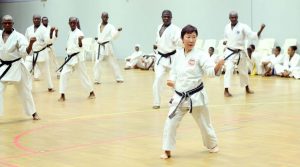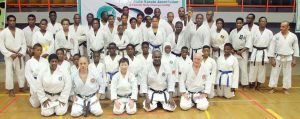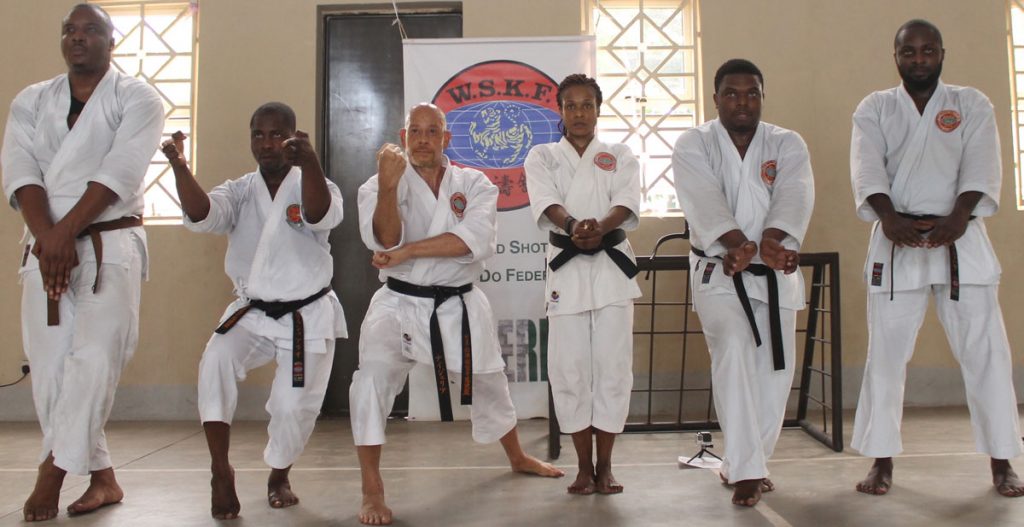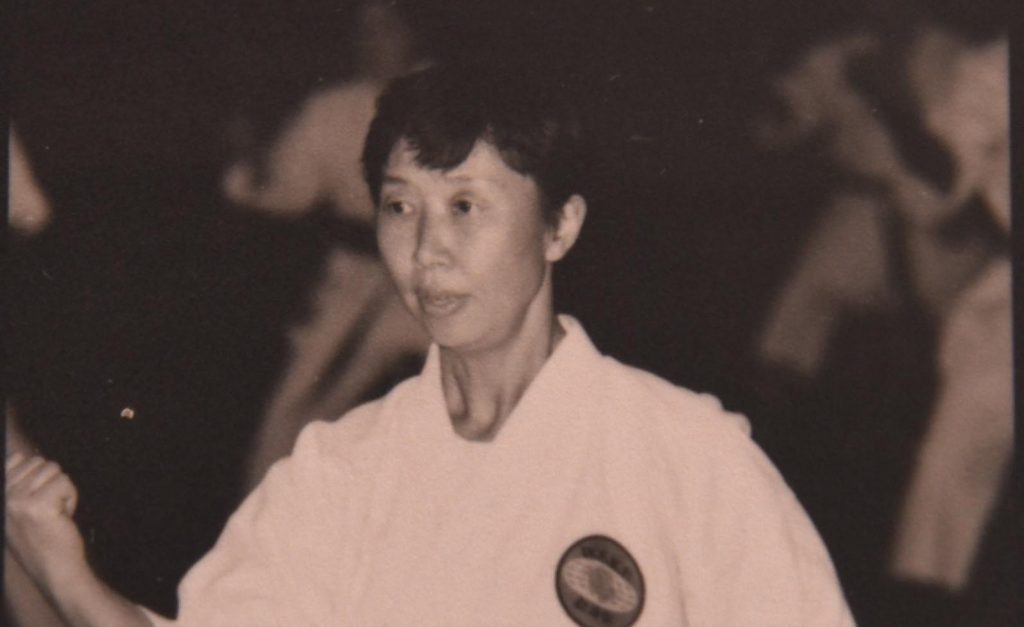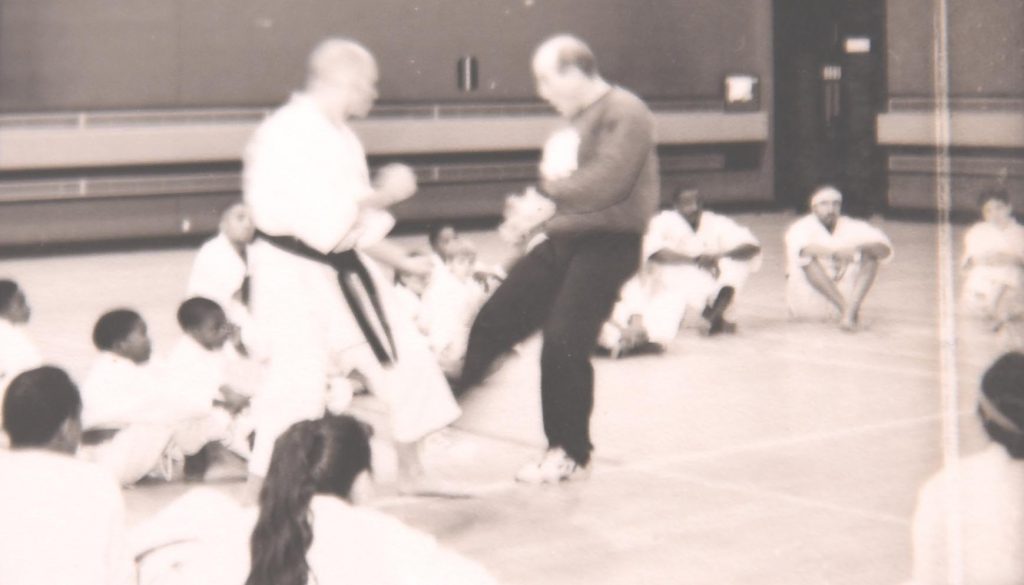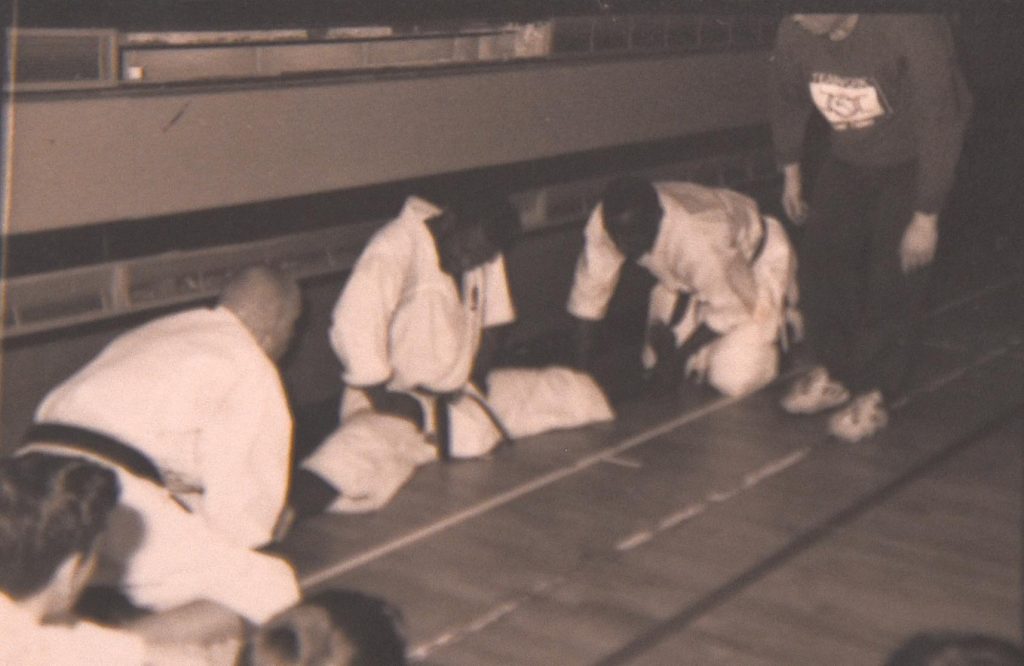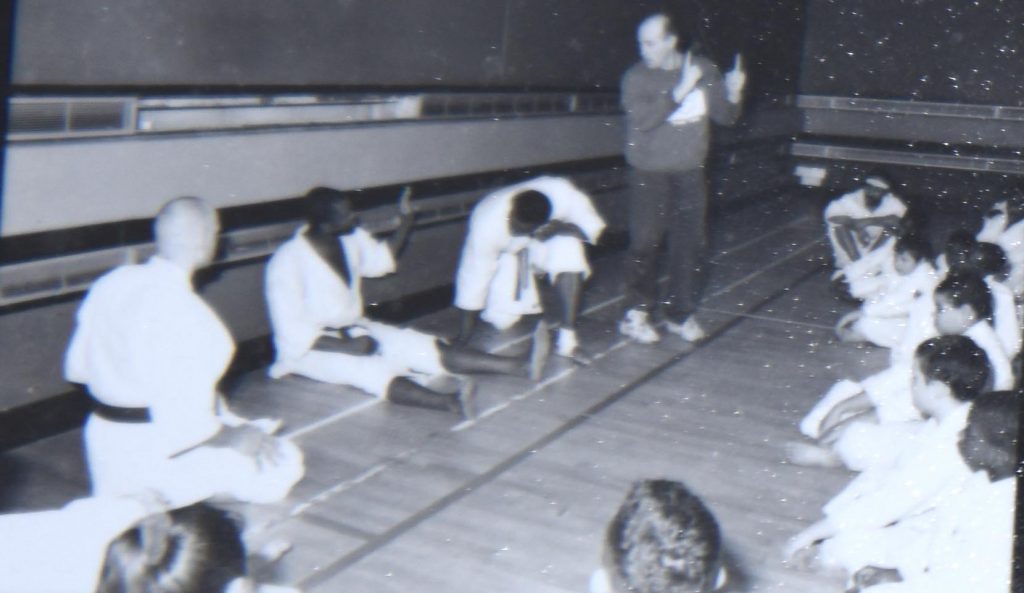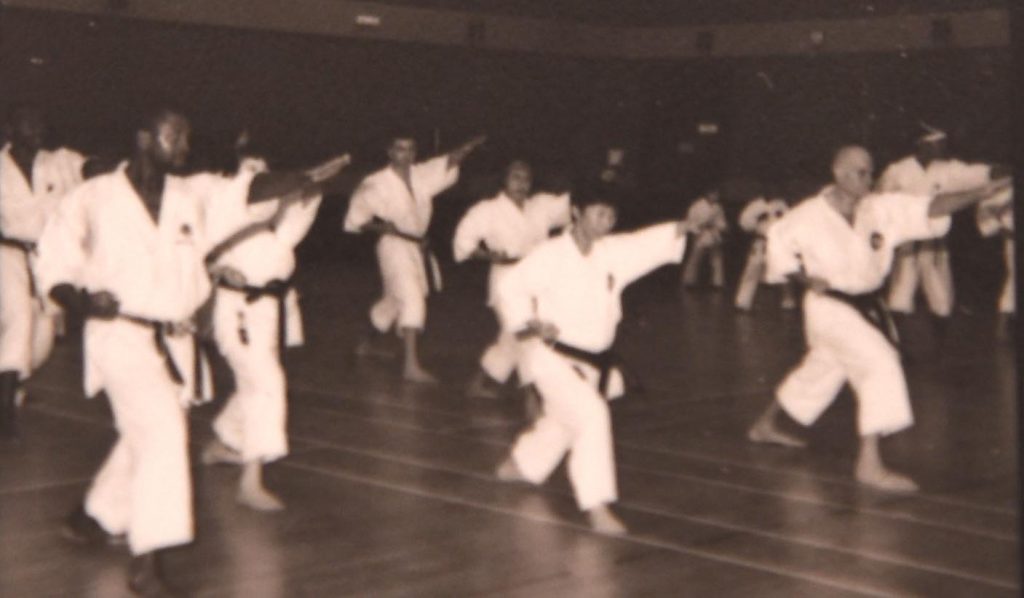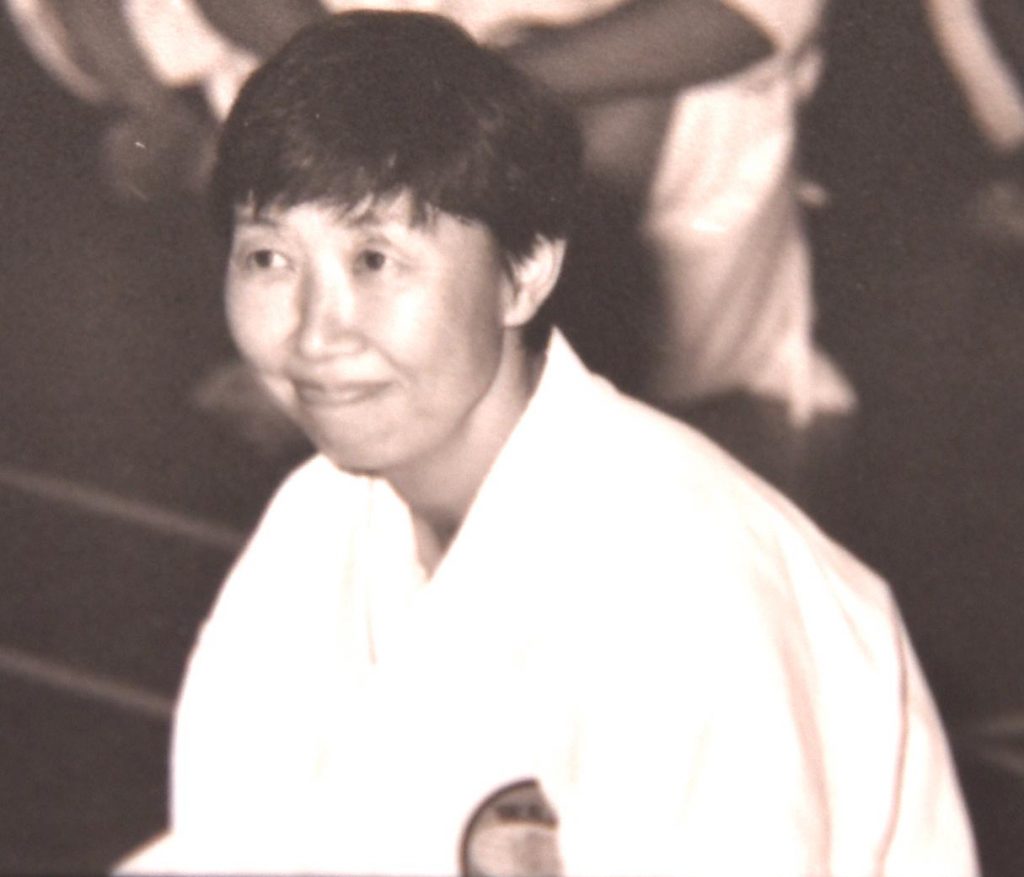Introduction
Tomiko Sensei was born in Japan in 1948 and started the study of shotokan karate in 1966 at the age of 18 years old, the initial purpose was to learn self defense as she was employed in a department store working long, late hours.
Tomiko Sensei remembers that it was not popular for ladies to study martial arts at that time and found it very difficult to join a dojo until her cousin who was a karate instructor introduced her to his sensei Hirano Sensei one of the original students of Master Funakoshi and one of the co-founders of the JKA. Karate training during this period was different from now, it was very strict and not much explanation just following instructions and training very hard. The lesson was 75% Kihon and 25% Kumite. Tomiko Sensei however say’s “I do try and en-cooperate some of the old ways with the new ways in order to keep training more interesting in my dojo “.
Tomiko Sensei travelled to England in 1971 to study English and returned in 1973 and joined Kanazawa Sensei “Yotsuya” Dojo where she trained three times a week under the resident instructor Seto Sensei at the time a nidan sensei (Seto Sensei not to be confused with his senior brother who won the JKA championship) and also Mrs. Kobayashi who was the first JKA kata woman’s champion. Master Kamiyanagi was the chairman of the dojo.
Additionally Sensei Tomiko attended Hoitsugan Dojo once a month where Nakayama and Kanazawa Sensei shared an apartment, The apartment had a basement where they had small dojo, many JKA instructors who had been abroad teaching Karate and returned to Japan also attended the dojo to train and exchange experiences under Kanazawa Sensei instruction, I was a 1st Dan at the time and learn’t all the shotokan kata’s from him Sensei Tomiko recalls.
After giving birth to her first son in 1978 already a 4th Dan she returned to training by this time Kanazawa Sensei and his dojo had already left the JKA and had formed the SKI. Kasuya Sensei was assisting with the training at the honbu dojo and their relationship continued to grow in to a senpei and kohai one. Due to various matters in 1990 Kasuya Sensei & Master Kamiyanagi decided to call a meeting to air their views, Tomiko sensei and about twenty Japanese black belts and instructors were at this meeting and the outcome was for them to form the WSKF. Tomiko Sensei said it was a shame that we lost Master Kamiyanagi last year after our 25 years anniversary and he cannot see the continous growth of WSKF today as we have over 200 dojo’s across the world now and student numbers continue to grow, one of recent country additions is Nigeria which I will be visiting in June this year for a seminar and open ladies only international competition.
Tomiko Sensei in her early days was very successful in karate competition and won many individual and team events in the JKA, SKI and WSKF now retired she is known as one of best Judges and Referees in the WSKF and attends all WSKF world championship where she is one of the chief referees or head judge.
Tomiko sensei is one of the very few Japanese women 8th Dan in the world and is also a member of WSKF Shihan-Kai Japan, she has been living and teaching karate in England since 1994 and is the WSKF England Technical Director and the chief instructor of the Renseikan WSKF dojos in the UK. Tomiko Sensei travels to other countries to teach and collaborates with other organizations to conduct courses in the UK.
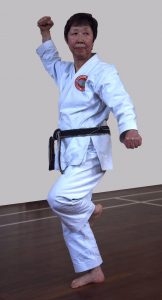
BB: Sensei how does it feel to be the highest female instructor in the WSKF and one of the very few 8th Dans in the world
TM: I feel very honored and proud however when I am in the dojo I am just a beginner again, it is important that it does not matter what grade you are, each time you go to the dojo, you must leave your ego outside, empty you mind and train as hard as you can, you must humble yourself, respect others, give courtesy where due, no body is perfect and once you start thinking like that you can not learn and it defeats the objective of “karate-do”
BB: There appears to be very few ladies in your dojo but mostly high graded male students.
TM: There are quite a few girls however over the years once the ladies get married and have children it is very difficult for them to come back to training due to all the domestic work that they have to do, I would also tell my female adult students that even if they can not train due to pregnancy or any other reason that they should try and come and watch so has to maintain a connection even the men if they have an injury I suggest this so it encourages them to return to training easier, watching is also very good as you can see others mistakes and then see if the same applies to you.
The male high grades in my dojo have been with me for many years, some came already dan grades and have gone through their grades with me and some have started from white belt, I am lucky to have plenty male high grades, quite a few are over 60 years old now and still training like 40 year olds. I also believe they like my way I teach, come to the dojo train hard and then leave, not much talking and leave, we do not have time for politics. After each class you will notice the senior grades doing self-practice and going over parts of the lesson with the junior grades just like any traditional dojo around the world.
BB: What is a typical class like in your dojo
TM: Typical traditional Japanese style, from the minute you enter the dojo, no idle chat, you start your own practice till the class is called. At the beginning of the class we have to clean the dojo floor before start the class, everybody in the dojo, all grades must take part, the cleaning is done with wet towels where the student pushes it the length of the dojo with his/her hands – this is correct attitude and must continue till the end of the dojo when the dojo kun is recited. Then we practice Kihon, maybe 60%, Kumite 20% and Kata 20%, during the class we just train with very limited talking – just quick corrections, discussions can take place after training, it appears to work very well in our dojo as I see the rate of improvement of my students, some visiting students do find it very hard to cope and train this way however after a few visits they adapt and enjoy the class.
BB: WSKF Kihon appears to have just as many spinning waza as non-spinning.
TM: Yes we have Kaiten Waza (Spinning Waza) and Tai Sabaki which we introduce into our syllabus from an early grade as these make the body and brain more agile, it creates different challenges for the students however as they progress this becomes more natural in Kumite and self defense, rather than just stepping only forward in attack or stepping back in defense, it is sometimes best to use Tai Sabaki has it is very effective allowing you to evade and give you the advantage of a counter attack using kaiten waza to your opponents blind side, however timing is very important and must be practiced over and over again.
BB: Sensei, what is your favorite waza?
TM: Gyakuzuki is my favorite waza just as many Japanese people, I perform it in many ways using Tail Sabaki, Kaiten and just basic to the front, I feel it is my strongest waza and I used in my competitions days, I continue practice it every day so I can get it faster, stronger, more kime and timing.
BB: Sensei, how about kicks,
TM: My favorite kick is mai geri, it is very strong and very effective, and you can maintain a very good guard and deliver a very strong and fast mai-geri at any height. Practicing the kick very slowly and getting your knee as high as possible before terminating it slowly with the toes pulled back, this also builds the muscles in both legs and torso and the standing foot facing the front helps improves the mai geri performance in all the katas.
BB: What is your favorite Kata
TM: My favorite kata is Nijushiho, which I used in grading examination and competition many times, it is a short kata but very difficult as it requires so much coordination, timing, rhythm, smooth stance changes. When performing kata it is very important to understand the theme and spirit of the kata so you can apply it and it makes it look beautiful, strong, and smooth like silk and graceful however deadly, The beginning of the Nijushiho is very important as that dictates the flow of the kata which should be like a wave and tide in harmony with fast and slow movements. Every time I practice I find more parts to practice harder and learning each time.
BB: How many katas does WSKF practice,
TM: We presently practice and teach twenty five shotokan katas however Jiin is not included as WSKF does not knows its history, we practice the kata’s as defined by Master Funakoshi just that our stances are higher, we feel that kata should remind the same and not be modified from the original form nor should we add any other katas to our syllabus as the ones that we have already we still have not mastered them yet, they require more and more practice to reach a zazen level, Kata practice for each person is personally and we must keep practicing them in order to improve each time and learn something different each time. Kata must be performed with the correct breathing, the right sequence, correct stances, kime, rhyme, timing, speed, mental focus and it should be performed with a harmonious flow.
BB: How important is application in your teaching of katas
TM: For me it is not so important to have a application for each waza of a kata, some of these waza in the kata could be miss understood and it is no good making up applications as I am sure we all have seen some strange ones over the years, if I do not know a application to a kata I will say I do not know it, however what I do teach is to take parts out of a kata and practice it in Kumite and Self Defense environment, this is the way I was taught in the early days and believe it is more realistic hence I continue to teach this way.
BB: Sensei –have you had to use karate outside the dojo
TM: Only once when I was a white belt on my way home from work one evening, a man that looked like a member of a street gang attacked me so I executed a Gyakuzuki to his solar plexes and then I ran as fast I could home.
BB: You have been practicing and teaching karate for the last 50 years what do you see as the major changes
TM: For me is that the grey areas of karate are becoming clearer, generally karate is more scientific and a lot of research is begin done on how best to practice a waza to get the best results, what impact it has on the joints and muscles, how to recover from injury quickly, how to train with disability or long term injury, which karate aids and tools are best to be use to get better results, what complimentary training we can do like conditioning especially core training, and ways to prevent inquiry. Kumite competition is slightly different, it is light and faster with more different scoring waza than before.
BB: Sensei – who has inspired the most
TM – Kasuya Sensei has been inspiring since I met him, he is such gentleman and caring instructor however still very strong, his karate is practical and natural, due to the number of years of continous teaching and his talent he is very good in getting the message across, every seminar that I attend with him he has different theme and all he knows, learns, researches he passes to his students all over the world, he is also strongly believes in budo and in respecting others, he makes karate practice in the dojo very interesting and inspires me to do the same. He also is very good at taking the every day life activities and relating them to Karate-do this way we are not only improving our karate but also enhancing our life out of the dojo. I am so lucky to have him as my sensei and my role model.
BB: Sensei – do you have any other past times or hobbies.
MT: Flower Arrangement, Tea ceremony, Cooking – the attitude is the same as karate, I am still learning and everyday I need to improve like in karate, there is always room for improvement which I continue to look for, if you think you are very good then you start going back wards and not forward, this is no good.
BB: Sensei – Have you not thought of teaching Japanese language to your students.
MT: I am good at teaching karate I think but I do not have patients to teach Japanese language, in the dojo we use Japanese names for the waza and read out the dojo code in Japanese.
BB: Apart from the obvious physical benefits, what can students gain from your style of hard traditional training?
MT: When you are training hard do you do not have time to think about anything else, no bunkai, no daily complicated matters, you just empty your mind, just concentrate in front of you, which releases stress. Hard training means its very tiring for your body, so you take care of what you eat, how to rest your body, you look after your health more.
BB: Do you think that nowadays there is too much emphasis on explaining karate rather than doing karate
TM: I think they are lazy, it is much easier just to talk and explain, rather than showing technique to your students, Have you noticed many older instructors are overweight? They just like to wear the dogi and put the black belt over their fat waist. In the past many instructors came to my dojo, none of them survived more than 30 minutes training with us
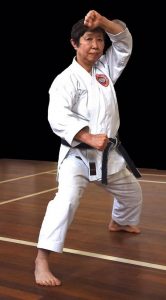
BB: You have always done hard traditional training, have you had many injury issues?
TM: Yes, Twice, One time my appendix burst and I had to have two operations
BB: Many people have said that the Japanese diluted the karate brought from Okinawa. Do you agree with that?
MT: Yes, the extreme style of karate in Okinawa would not be carried out by normal Japanese people. As you know many Okinawa Karate Instructors do not live long.
BB: Why do you think that so many of us are still following the Shotokan style, with the plain white dogi, strict dojo etiquette etc when all around us we have MMA and Taekwondo etc?
MT: Shotokan karate is simple and effective and there’s nothing wrong with plain white dogi and strict rules. One time a MMA black belt came to my course, I thought his karate waza looked like a 5th kyu ! I do not know much about Taekwondo so I can not comment on that.
BB: What is your personal philosophy towards karate
MT: Karate is everything to me, it is my way of life, and it gives me purpose. I have had a lot challenges in my life and still found time to do karate, it gave me focus and made it easy for me to tackle the challenges with out any ill effects, one incident was so bad that all the other people affected became very sick but I continued and the matter ended, I feel I am a nobody with out karate and will be lost without it, it provides me with guidance, discipline, perseverance and gives me respect as I respect others.
BB: What would be your advice to other karate-ka
MT: What ever happens in your life you should find time to train if not in the dojo at home, sometimes you might feel that you do not want to train but you should please convince yourself otherwise. Karate makes the body and brain agile by exercising it and learning everyday, this allows us to be fitter, strong and more mental alert in our old age than those that do not do any form of exercise, it is said that Karate uses almost all our muscles during training, it maintains your flexibility, coordination and balance. Always train harder than last time, listen, and watch and understand then do, when learning something new, do not panic always remain calm and do not rush in your training. Do try and practice at home even if is 10mins per day. Never think that you know it all keep practicing and enjoy your karate.
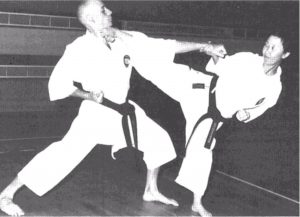
Above Tomiko Sensei with Bob Bamgboye in 1995 and below 2016
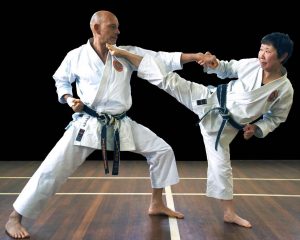
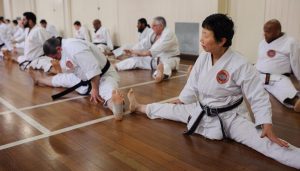
Tomiko Sensei warming up recently on Kasuya Sensei seminar in England March 2017
Tomiko Sensei at the age of 69 is still actively teaching twice week at her dojo in Slough, visits and teaches at all the WSKF dojo’s in England and aboard, in 2016 she visited Nigeria for the first time and instructed on an Open Karate Seminar and taught in the Renseikan Dojos in Lagos.
